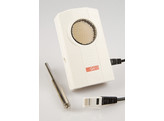Motion Detector
The Motion detector 0664 is a sonar device that emits ultrasonic pulses, which reflect off an object. The sensor measures the time it takes an ultrasonic pulse to travel from the sensor to the object and determines the distance from the object based on the measured time and the speed of sound. While the Motion detector is operating, a slight clicking sound from the sensor will be heard. The minimum range of the motion detector is 0.20 meters. The maximum range is 6 to 12 m, depending on the size, shape, orientation and surface of the object that is detected. Note that the maximum detection distance of 12 m can only be reached under ideal conditions, i.e. for a large, flat surface (e.g. a wall) that is perpendicular to the detector. For smaller objects or objects that are not very flat, the maximum detection distance will be smaller.
The motion detector has mounting threads on the bottom and both sides of the unit. These threads can be used to mount the detector to a stand and they are compatible with typical tripod mounting hardware. The sensor is supplied with a steel rod, which can be screwed into a mounting thread. The rod can be used for clamping into a suitable holding device, e.g. a retort stand.
The Motion sensor can be used for studying a variety of motions including:
• Walking toward and away from the sensor.
• Simple harmonic motion, such as a weight hanging on a spring.
• Newton’s laws of motion.
• Acceleration due to gravity - free fall, objects dropped or tossed upward.
• Air track experiments.
The Motion detector can be directly connected to the digital BT inputs of the CMA interfaces (CoachLab II/II+ and VinciLab).
For CLAB and WiLab you can use Motion detector BT55i.
Technical specifications of the sensor are described in its User's guide.
The Motion detector 0664 is a sonar device that emits ultrasonic pulses, which reflect off an object. The sensor measures the time it takes an ultrasonic pulse to travel from the sensor to the object and determines the distance from the object based on the measured time and the speed of sound. While the Motion detector is operating, a slight clicking sound from the sensor will be heard. The minimum range of the motion detector is 0.20 meters. The maximum range is 6 to 12 m, depending on the size, shape, orientation and surface of the object that is detected. Note that the maximum detection distance of 12 m can only be reached under ideal conditions, i.e. for a large, flat surface (e.g. a wall) that is perpendicular to the detector. For smaller objects or objects that are not very flat, the maximum detection distance will be smaller.
The motion detector has mounting threads on the bottom and both sides of the unit. These threads can be used to mount the detector to a stand and they are compatible with typical tripod mounting hardware. The sensor is supplied with a steel rod, which can be screwed into a mounting thread. The rod can be used for clamping into a suitable holding device, e.g. a retort stand.
The Motion sensor can be used for studying a variety of motions including:
• Walking toward and away from the sensor.
• Simple harmonic motion, such as a weight hanging on a spring.
• Newton’s laws of motion.
• Acceleration due to gravity - free fall, objects dropped or tossed upward.
• Air track experiments.
The Motion detector can be directly connected to the digital BT inputs of the CMA interfaces (CoachLab II/II+ and VinciLab).
For CLAB and WiLab you can use Motion detector BT55i.
Technical specifications of the sensor are described in its User's guide.
Properties
- CMA.0664

